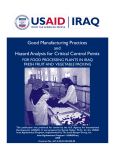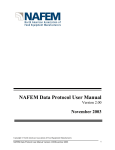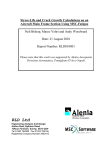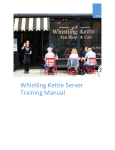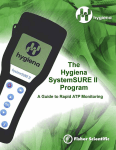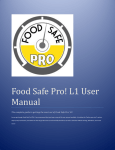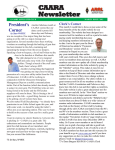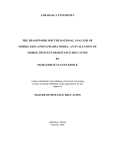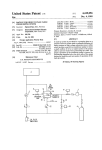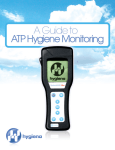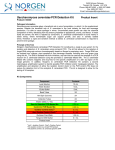Download GMP and HACCP for Almond Processing for Afghanistan
Transcript
GMP and HACCP for Tree Nuts and Dried Fruit Processing Plants in Afghanistan Submitted by Kamal Hyder, Ph.D. Submitted to: USAID Prime Contractor: Chemonics International Inc., Rebuilding Agricultural Markets Program (RAMP) April 2006 This publication was made possible through support provided by the U.S. Agency for International Development, under the terms of Contract No. 306-C-00-03-00502-00-ROP, Rebuilding Agricultural Markets in Afghanistan Program (RAMP), Job No. 29 Grape Revitalization for Afghanistan Productivity and Empowerment Project (GRAPE). The opinions expressed herein are those of the author(s) and do not necessarily reflect the views of the U.S. Agency for International Development (USAID). ACKNOWLEDGEMENTS Roots of Peace would like to thank the following individuals for their efforts in the development of this publication: Dr. Kamal Hyder, author Dr. Mike Villaneva, technical editor Dr. John Dale “Zach” Lea, publishing editor/manager Mr. Philippe Chabot, assistance in arranging technical editing Dr. Wais Farda, Farsi/Dari translator Dr. Mohammed Saber Perdes, Pashto translator Mr. Gary Kuhn, Executive Director, Roots of Peace Dr. Kenneth Neils, RAMP Director of Agriculture Technology and Marketing Development ABBREVIATIONS RAMP USAID Rebuilding Agricultural Markets in Afghanistan. A project of the U.S. Agency for International Development and the Ministry of Agriculture, Animal Husbandry and Food, Islamic Republic of Afghanistan U.S. Agency for International Development FDA US Food and Drug Administration Table of Contents 1 Introduction.................................................................................................................................. 1 2 Good Manufacturing Practices (GMPs)....................................................................................... 1 2.1 Plant and Grounds................................................................................................................. 1 2.2 Design of Equipment and Utensils ....................................................................................... 3 2.3 Sanitation Facilities and Controls ......................................................................................... 3 2.5 Sanitary Operations............................................................................................................... 4 2.6 Processes and Controls ......................................................................................................... 5 2.7 Personnel............................................................................................................................... 6 3 Hazard Analysis for Critical Control Points (HACCP) ............................................................... 6 3.1 Definition of Terms used in HACCP.................................................................................... 7 3.2 Seven Principles of HACCP ................................................................................................. 9 3.3 Critical Steps for the Development of HACCP .................................................................. 10 3.4 The Hazard Analysis Process.............................................................................................. 10 3.5 Determination of the Critical Control Points (CCP)........................................................... 12 4 General Management Principles ................................................................................................ 13 4.1 Record Keeping .................................................................................................................. 14 4.2 Management Policies for Plant ........................................................................................... 14 3 GMP and HACCP for Almond and Dried Fruit Processing Plants in Afghanistan 1 Introduction Food processing plant owners have a social responsibility to insure that the food they produce and sell to the general public will not damage consumers’ health. Responsible plant owners take many steps to make sure that the food they produce is healthy and wholesome for human consumption. The cumulative steps result in a food quality assurance system that includes: • Good Manufacturing Practices (GMP) and • Hazard Analysis and Critical Control Points (HACCP). The purpose of this manual is to assist owners and managers of nut and dried fruit processing plants in Afghanistan obtain a basic understanding of these components of a responsible food quality assurance system and alert them to important issues to consider when installing and operating these systems. The manual will discuss basic concepts and suggest the food safety and quality assurance system that should be implemented in tree nuts and dried fruit processing plants in Afghanistan. The actual procedures and programs for nut and dried fruit processing plants in Afghanistan should be developed and installed with the help of food processing experts, employed either by the individual plant owners or through some organization of plant owners. 2 Good Manufacturing Practices (GMP) Good manufacturing practices are the procedures that should be followed during plant construction and operation to assure food wholesomeness. GMP refers to the minimum sanitary and processing conditions required in a properly built processing plant 1 . GMP contains cleanliness and sanitary requirements for personnel, building and facilities, equipment and utensils, in addition to food processing requirements and controls. Cleaning and sanitation is a multi-step procedure that involves first cleaning and then sanitizing in the food processing plant. Food processing refers to the actual manufacturing operations, such as shelling, sorting and packaging nuts that are applied to the food product. When implemented properly, GMP not only reduces new forms of biological, chemical and physical contamination, but eliminates existing contamination. Food processing plants must be constructed with these practices in mind. To comply with US and European standards, processing plants must be constructed with approved materials and maintained under hygienic and sanitary conditions. Construction materials should be safe, nontoxic and approved for use in a food processing facility. All of the equipment, walls, floors, doors, windows, and fixtures must meet approved standards. The plant layout should be such that it can avoid accumulating dirt and can be easily cleaned and sanitized. 2.1 Plant and Grounds The design of the plant layout should include the following points: • The ground selected should be above the road level and water drainage system. 1 Refer to the United States Food and Drug Administration (FDA) codes in Section 21 of the Code of Federal Regulations, Part 110 for further detail. 1 • • • • The building should be a few feet above ground level for cleaning water to flow out. Adequate protection should be provided against rain and dust storms. Areas for incoming raw material and outgoing finished goods should be segregated. Plumbing must be of adequate size and design to: o Supply enough water to areas in the plant where it is needed. o Properly convey sewage or disposable liquid waste from the plant. This room in an almond processing facility exemplifies GMP. Walls, floors and equipment are all made of materials that are easily washed and sanitized. Also note the ample amount of lighting. Note the insect electrocuter on the wall. • Not create a source of contamination or unsanitary condition. o Provide adequate floor drainage where hosing-type cleaning is done or where operations discharge water or liquid waste onto the floor; floor drains must be designed to trap material that could clog the drainage system; floor drains must be designed for easy cleaning to remove trapped material. Where practical, any solid material that can clog the drains should be removed prior to disposal. o Water supply for the plant should be tested to see if it is potable. High bacterial count and excessive mineral content should be eliminated by treatment with chlorine and filtration or ion exchange system. 2 • • • • • • • • o Used process water should also be treated before disposal to reduce biological and chemical oxygen in the effluent. o There should be no backflow from cross-connections between piping systems that discharge waste water or sewage and those that carry water for nuts. Air filters should be used to clean air for in-plant use. Any emission of air with high polluting materials should be filtered or scrubbed prior to its discharge. Electricity should be supplied through a distribution switch board. Proper safety switches and fuse boxes should be installed to avoid overload and electrical fires. Wiring inside the plant should be protected with waterproof covering that can be wiped during clean up. In some cases stand by generators may be needed for refrigerators and freezers to avoid spoilage due to electrical interruptions. Lighting and ventilation systems should be adequate for visibility and safety. All entry points to the building should be secured against insects, rodents and other animals. The doors, windows, walls, floors and ceilings should be made of smooth surfaces that can be easily wiped and cleaned. Materials used in construction of floors and walls should be non-toxic. o Cement walls and floors are acceptable if they are smooth enough without rough corners and crevices. Special plastic wall covers such as “Kimlite” panels may be ideal because they can be easily washed and wiped. o Wooden doors and windows may be covered with thin stainless steel sheets; but, if metal doors and windows are available they are preferable. Toxic materials such as lead paint must not be used. Asbestos sheet ceilings should be absolutely avoided. Some plants use galvanized iron sheets as roofs. This would require a false ceiling of plastic material to cover the iron sheets from the inside. 2.2 Design of Equipment and Utensils Equipment and utensils must be designed for easy cleaning and sanitation. Equipment and utensils must be made from non-corrosive materials. 2.3 Sanitation Facilities and Controls • • Toilet, hand-washing, ablution and locker-room facilities: o Toilets and hand-washing facilities must be provided inside the nut processing centre; o Toilet tissue must be provided; o Toilets must be kept sanitary and in good repair; o Signs must be posted that direct employees to wash their hands with soap or detergent after using the toilet. o Toilet rooms must have self-closing doors; o Toilet rooms must not open directly into areas where nuts are exposed unless steps have been taken to prevent airborne contamination (example: double doors, positive airflow, etc.); Hand-washing facilities must provide: o Running water at a suitable temperature; o Effective hand-cleaning and hand-sanitizing preparations; 3 o Clean towel service or suitable drying devices; o Easily cleanable waste receptacle; o Water control valves designed and constructed to protect against recontamination of clean, sanitized hands; o Signs directing employees handling unprotected nuts to wash and, if appropriate, sanitize theirs hands before starting work, after each absence from the workstation, and any other time when the hands have become soiled or contaminated. This washroom sink area in an almond processing facility has adequate hot water, soap, hand towels, and signs reminding employees of the requirement to wash hands before working. It is also emaculately clean. 2.5 Sanitary Operations HOUSEKEEPING The plant must develop Standard Operating Procedures (SOPs) and Standard Sanitary Operating Procedures (SSOPs) relative to all cleaning and sanitizing of the plant facilities and equipment. Cleaning operations must be conducted in a manner that will minimize the possibility of contaminating nuts and equipment surfaces that contact nuts. Cleaning removes the visible soil and organic matter and most of the harmful bacteria. 4 Plant personnel use brooms, brushes, high pressure air, low and high pressure water to remove visible soil and organic matter from: • Plant floors • Plant walls • Equipment and utensils, which must be kept in a sanitary condition through frequent cleaning and, when necessary, sanitizing. If necessary, such equipment must be taken apart for thorough cleaning. Cleaning is done on a pre-planned, regular schedule. Most cleaning operations are conducted at the end of the work day or at a prescribed time before the shift begins. Sanitation requires that a sanitizing compound such as chlorine be applied to the cleaned surfaces so that the level of bacteria can be reduced to an acceptable level. Sanitation is done at different times for various parts of the plant. The following is a recommended schedule of sanitation for the various parts of a processing plant: • Plant floors every day and during mid shift • Plant walls every day before each shift • Equipment before use for every batch • Other utensils prior to use PEST CONTROL Food plants must have structures to control insects, rodents, birds, cats and other animals. Flies, bees, rats and mice invade the food plants in search of food. Cats and other animals enter the plant in search of rats and mice. All structures and equipment should be secured against them. Doors, windows and other openings must be secured. Openings that are typically left open for ventilation should be screened. Installation of air curtains, fans and electrocutors at strategic locations will be extremely helpful. Snap traps, glue boards and bait stations must be placed around the immediate building exterior and interior walls. 2.6 Processes and Controls RAW MATERIALS AND CONTAINERS Raw product and finished product must be stored in segregated areas under conditions that prevent contamination and the growth of undesirable microorganisms. Product flow zones must be protected from all sources of contamination. FOOD PROCESSING It is necessary to process, package and store nuts under conditions that will minimize the potential for undesirable microbiological growth, toxin formation, deterioration or contamination. This will require careful monitoring (via a HACCP program described below) of such factors as time, temperature, humidity, pressure, flow rate, etc. The object is to assure that mechanical breakdowns, time delays, temperature fluctuations or other factors do not allow the nuts to decompose or become contaminated. Good manufacturing practices include the following: • Nuts must be held under conditions that prevent contamination and the growth of undesirable microorganisms. 5 • • • • • Mechanical manufacturing steps such as shelling and packaging, etc. must be performed in a manner that: o provides adequate protection from contaminants that may drip, drain or be drawn into the nuts, o adequately cleans and sanitizes all nuts-contact surfaces o uses materials for nut containers and nut packaging materials that are safe and suitable o uses an HACCP program to check for possible contamination and assure that GMPs are being followed. Measures such as sieves, traps, or metal detectors must be used to protect against the inclusion of metal or other extraneous material in nuts; Measures such as sterilizing, irradiating, or pasteurizing must be adequate to destroy or prevent the growth of undesirable microorganisms. Equipment, containers and utensils must be constructed, handled and maintained to protect against contamination. Nuts that are adulterated must be disposed of without contaminating other nuts; PACKAGING, CODING AND FINISHED FOOD PRODUCTS • A coding system should be utilized that will allow positive lot identification in the event it is necessary to identify and segregate lots of nuts that may be contaminated. • Records should be kept for a period of time that exceeds the self life of the product. 2.7 Personnel Employee sanitation requires that plant personnel use personal hygiene to insure that food products do not become contaminated. Personal hygiene for processing plant personnel includes: • Use of protective clothing, shoes, hair-nets, beard guards, etc. approved by management. • Washing and sanitizing of hands and body parts that may come in contact with the food during preparation. • Food processing personnel should not wear jewelry while processing food. The owner of the processing plant should establish strict jewelry rules so that watches, rings, earrings etc. are not worn by processing personnel and may not contaminate the products. The plant owner should provide a place for plant personnel to safely store their jewelry prior to entering the processing areas. • All personnel should be screened regularly for any illness that can be transmitted to food. 3 Hazard Analysis for Critical Control Points (HACCP) HAACP is a system for monitoring food-processing plants to insure that all established procedures for maintaining food quality are followed. It establishes a series of scheduled inspections in the plant at critical points of manufacture. Physical, chemical and biological tests are performed at the critical points. When the results are acceptable, food processing/manufacturing moves forward. When the results of tests are unacceptable, food processing ceases until the problems are corrected. HACCP is not a stand-alone system. It requires GMP to be in place before HACCP can be applied. It is now used extensively in the food industries all over the world for making sure that 6 Workers in this almond processing facility are wearing proper protective clothing and have removed all of their jewelry. processed foods are prevented from contamination with hazardous elements, pathogenic microorganisms, physical objects like glass, metal or bone, and chemicals like toxins, heavy metals or pesticide residues. It helps monitor strict adherence to processing and storage parameters. 3.1 Definition of Terms used in HACCP Many terms used in discussion of HACCP must be clearly understood to effectively develop and implement a plan. The following definitions are provided for clarity: • Acceptable level means the amount of a hazard that is unlikely to cause a health risk. • Control point means any point where loss of control does not lead to an unacceptable health risk. • Critical control point, as defined in the Food Code, means a point at which loss of control may result in an unacceptable health risk. • Critical limit, as defined in the Food Code of the FDA, means the maximum or minimum value to which a physical, biological, or chemical parameter must be controlled. • Deviation means failure to meet a required critical limit for a critical control point. 7 • HACCP plan, as defined in the Food Code, means a written document that delineates the formal procedures for following the HACCP principles developed by The National Advisory Committee on Microbiological Criteria for Foods. • Hazard, as defined in the Food Code, means a biological, chemical, or physical property that may cause an unacceptable consumer health risks. • Monitoring means a planned sequence of observations or measurements of critical limits designed to produce an accurate record and intended to ensure that the critical limit maintains product safety. Continuous monitoring means an uninterrupted record of data. • Preventive measure means an action to exclude, destroy, eliminate, or reduce a hazard and prevent recontamination. • Risk means an estimate of the likely occurrence of a hazard. • Sensitive ingredient means any ingredient historically associated with a known microbiological hazard that causes or contributes to production of a potentially hazardous food as defined in the Food Code of the FDA. • Verification means methods, procedures, and tests used to determine the HACCP system to be in compliance. • Flow chart is a diagram that shows how products move through a processing plant. Each step or node on the flow chart represents a separate operation that is applied to the product. The first operation in the flow of product through the plant is reception of the raw product, such as whole almonds. Shelling and packaging are examples of other operations that are applied to the product as it flows through the plant. Such operations are represented as nodes on the plant’s flow chart. One of the first steps in establishing HACCP in a plant is to prepare a flow chart with potential hazards identified at each step 2 . Below is an example flow chart in tabular form for a typical almond processing plant. Step 1 Step 2 Step 3 Step 4 Step 5 Step 6 Step 7 Step 8 Step 9 Step 10 Step 11 Step 12 Step 13 Step 14 Step 15 Receiving raw materials in the bulk storage bins at the plant Fumigation of raw materials to kill insects and molds prior to processing Storage of fumigated raw materials in the processing area Hulling and shelling of the almonds to remove the kernels Sizing and sifting of kernels for grading Pass through magnets to remove magnetic materials Initial quality check to observe any visible defects Quality control tests for moisture, density, oil content and bitterness Pass through metal detector to isolate magnetic and non-magnetic materials Final quality check for physical, chemical and sensory tests Bagging and boxing of kernels Random batch tests of packaged products for quality assurance Final fumigation to avoid any recontamination with insects and molds Storage of finished packaged products in a cool dry place Shipping of products in bags, boxes and large containers with batch control for any recall of product from the market 2 For further detail on flow chart and critical control points for HACCP consult the HACCP User’s Manual by D.A. Corlett,Jr. 1988. Aspen Press, Gaithersburg, MD, USA. 8 3.2 Seven Principles of HACCP Seven principles are applied to establish an HACCP program. They are given below with reference to almond and dried fruit processing industries. 1. Perform analysis of hazard (type of physical, chemical and biological hazard in almonds) 2. Determine critical control points (locate the areas during handling and processing of almonds) 3. Establish limits for the critical control points (establish the safety limits acceptable at the points) 4. Monitor critical control points (check and re-check the occurrence of hazards at the points) 5. Take corrective action (establish procedures to eliminate the hazards through treatments) 6. Keep records (maintain the history of events that includes observation, action and results ) 7. Verify that the system works (check and re-check that the procedures are updated and functioning). The large bins in this picture contain almonds at the intake stage of this plant’s processing line. Nuts in this stage must be separated from those in other areas of the plant to eliminate the possibility of contamination. 9 3.3 Critical Steps for the Development of HACCP The following steps are essential for consideration at the time of establishing an HACCP program. • Assemble a multi-disciplinary team that includes managers, scientists, process workers, engineers and book keepers so that intelligent input can be provided at periodic HACCP meetings. In the case of almond processing, people with knowledge of almond growing, handling, storage and distribution should be included to provide input of the local conditions. • Engage an external safety consultant with technical knowledge to provide guidance at the HACCP meetings. The consultant can coordinate the external testing and laboratory services and discuss test results and corrective measures. • Prepare a flow chart of the operation of almond processing. This should be a step by step flow chart. • Examine the steps and identify the hazards at each step. • Determine curative measures such as cleaning the surfaces in contact with the product or reducing airflow on the almonds that can contaminate them. • Establish tests to measure the elimination of contaminants. A metal detector at a critical point may show metal contamination. Use of magnetic devices at the points may remove the metal objects detected. • Record all sources of ingredients to establish traceable connections to eliminate hazard sources. • Display the critical control points and repeat the review of actions taken periodically, like daily, weekly and monthly. • Standardize procedures and update them as frequently as possible with new techniques. • Make sure that the management approves and signs records of inspections regularly. 3.4 The Hazard Analysis Process The hazard analysis process consists of asking a series of questions at each operational step in the processing of the product as it flows through the plant. The analysis examines the effect of a variety of factors upon the safety of the food. Sample questions are given below. 3.4.1. Ingredients • Do the almonds contain any sensitive ingredients that are likely to present microbiological hazards (e.g., Salmonella, Staphylococcus aureus), chemical hazards (e.g., aflatoxin, antibiotic, or pesticide residues) or physical hazards (stone, glass, bone, or metal)? 3.4.2. Intrinsic factors of food • Which intrinsic factors of the food must be controlled in order to ensure food safety? Physical characteristics and composition (e.g., pH, type of acids, oils, fermentable carbohydrate, water activity, preservatives) of the almonds during and after preparation can cause or prevent a hazard. • Will the food permit survival or multiplication of pathogens and/or toxin formation during processing, storage, or consumer possession? 10 • Are there other similar products in the market place? What has been the safety record for these products? 3.4.3. Procedures used for preparation/processing • Does the preparation procedure or process include a controllable step that destroys pathogens or their toxins? Consider both vegetative cells and spores. • Is the product subject to recontamination between the preparation step (e.g., drying, cooking, etc.) and packaging? 3.4.4. Microbial Content of the Food • Is the food commercially sterile (i.e., low acid canned food)? • Is it likely that the food will contain viable spore-forming or non-spore-forming pathogens? • What is the normal microbial content of the food stored under proper conditions? • Does the microbial population change while the food is stored before consumption? • Does that change in microbial population alter the safety of the food? 3.4.5. Facility design • Does the layout of the facility provide an adequate separation of raw materials from ready-to-eat foods? • Is positive air pressure maintained in product packaging areas? Is this essential for product safety? • Is the traffic pattern for people and moving equipment a potentially significant source of contamination? 3.4.6. Equipment design • Will the equipment provide the time and temperature control that is necessary for safe food? • Is the equipment properly sized for the volume of food that will be prepared? • Can the equipment be sufficiently controlled so that the variation in performance will be within the tolerances required to produce a safe food? • Is the equipment reliable or is it prone to frequent breakdowns? • Is the equipment designed so that it can be cleaned and sanitized? • Is there a chance for product contamination with hazardous substances? • What product safety devices, such as time and temperature integrators, are used to enhance consumer safety? 3.4.7. Packaging • Does the method of packaging affect the multiplication of microbial pathogens and/or the formation of toxins? • Is the packaging material resistant to damage, thereby preventing the entrance of microbial contamination? • Is the package clearly labeled "Keep Refrigerated" if this is required for safety? • Does the package include instructions for the safe handling and preparation of the food by the consumer? 11 • • • Are tamper-evident packaging features used? Is each package legibly and accurately coded to indicate production lot? Does each package contain the proper label? Almonds stored in packages and loaded on palettes at the end of their processing. Each box has detailed information about the production lot to aid in a recall and an HACCP analysis of the source of the hazard. 3.5 Determination of the Critical Control Points (CCP) Determination of the Critical Control Points (CCP) is made by analyzing each operational step in the flow of product through the plant to evaluate the potential for contamination by biological, chemical and physical vectors. The table below provides an example of the analysis of the flow of product through a typical nut processing plant in Afghanistan. At each step in the processing the potential for biological, chemical or physical contamination is analyzed. Critical Control Points (CCP) are identified where the potential for contamination is significant. HACCP Flow Chart of Almond Processing Plant with examples of CCP Operation Receiving Biological Control Point Check Chemical Control Point Check Physical Control Point Check dirt, Remedy Treatment to Critical Control Point Yes 12 bacteria, mold Kill insects, mold pesticide & insecticide Hulling/ Shelling Check for bacteria and mold Check for chemical residue Sizing & Grading Quality check Quality check Line & QC Inspection Final line check for bacteria and mold Final line check for any foreign material Packing Check packaging materials for bacteria Final line check for any chemical residue Check packaging materials for chemicals Storage Check storage area Check storage area Check storage area Shipping Check shipping condition Check shipping condition Check shipping condition Fumigation debris & filth Check for insect fragments Check for discolored hulls, shells etc. Quality check Check any damage and tear remove them Treat and remove physically Remove the discolored nuts Yes Remove broken and off grade nuts Eliminate the off grade items and clean nuts No Yes Yes Eliminate Yes the packaging materials and cartons Make sure Yes the storage area is clean and dry Clean the Yes shipping vehicles Note: The sizing and grading operation may not be directly related to health hazards but for quality of nut size and grade, the operation is critical. Tests will have to be performed regularly in the plant. Some examples of tests are given below. • For visual tests, magnifiers, microscopes and UV lights will be needed. • For color control of the almonds, color charts or electronic eyes for color comparison may be needed. • For microbiological examination, equipment will be needed for incubation and plate count • For physical debris and filth removal, sifting devices, cyclones and dust removal equipment will be needed. 4 General Management Principles Management support and involvement are extremely important in achieving success. The following points for record keeping and plant policies are of paramount importance. 13 4.1 Record Keeping The procedure of testing and re-testing requires record keeping in an archive that is chronological, permanent and readily accessible. It should be maintained by the management in a safe and secured place. This will also help product recalls if they are needed. 4.2 Management Policies for Plant All policies regarding the hygiene of employees and visitors should be posted in prominent places. They should be strictly enforced. Safety of material handling should also be monitored with great care. ( Note: Further illustrations pictures may be added to the appendix or in the GMP section of the text). Suggestions for pictures from the CD from Lynn are: GMP 001 showing the almond processing plant area with floor, ceiling, walls and people. GMP011 showing details of the ceiling and the painted surface. GMP022 showing the wash basins and the counter top GMP026 showing lighting and ducts in the plant You may add one or two more pictures to show the details of product line and storage. 14

















